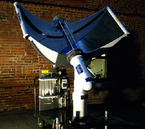Solar Hydrogen Company Secures $4.7M in Series A Round
16 January 2008
 |
| Second-generation prototype Solar Hydrogen Generator with solar concentrator. |
Nanoptek Corporation, a renewable energy company that produces hydrogen directly from water using sunlight and its proprietary photocatalyst, has closed a $4.7 million Series A equity financing round led by The Quercus Trust, a California fund with multiple investments in clean technology and renewable energy.
Ardour Capital Investments, LLC served as financial advisor in the transaction. Series A investors also included the Massachusetts Technology Collaborative (MTC) and private investors. With this investment, Nanoptek expects to complete the development of its field-deployable Solar Hydrogen Generator, develop pilot manufacturing capability, and install its first pilot plant for producing carbon-free hydrogen.
Nanoptek’s Solar Hydrogen Generator (SHG) produces hydrogen directly from water using only sunlight and its proprietary photocatalyst in a process known as photoelectrochemical (PEC) water dissociation, or photolysis. No carbon dioxide is produced.
In electrolysis, electricity passed between two electrodes immersed in a water and salt electrolyte dissociates the water into pure hydrogen and oxygen. Replacing one of the electrodes with a photoactive semiconductor such as titania produces hydrogen directly when illuminated with sunlight. Sunlight produces electron-hole charge pairs in the titania that break water into hydrogen and oxygen in a reduction-oxidation, or redox, reaction. However, the lifetime and efficiency of PEC technology to date has not been not commercially viable.
Nanoptek has developed an improved titania photocatalyst by developing a process that coats a thin film of titania semiconductor onto a plastic nano-structured surface that induces large local nano-scale stresses in the titania. These stresses stretch the titania crystal lattice so that electrons are held less tightly in the lattice and so can be knocked out of the titania with light of lower energy. These electrons then drive the hydrogen production.
This bandgap engineering enables Nanoptek’s titania photocatalyst to be photoactive well into the visible blue, and so is six times more efficient in sunlight than native titania, which requires the sparse ultraviolet (UV) part of the solar spectrum, according to the company.
The performance of Nanoptek’s titania improves with heat, so heat from the sun can be used to further increase the efficiency of the photolysis process, and solar concentrators can be used for better economics. The manufacturing process is scalable, low cost, and requires less energy than other processes.
The first-generation prototype in 2004 had an effective area of 0.25m2 and produced hydrogen at the rate of 3 liters/hour or 720 liters/month. Light harvest efficiency was 37% and photon conversion efficiency was 9.6%
Nanoptek developed the technology over 5 years with funding from NASA, the US Department of Energy (DOE) Office of Basic Energy Sciences, and a SEED (Sustainable Energy Economic Development) loan from the Massachusetts Renewable Energy Trust totaling over $1.3M.
Nanoptek expects to sell the carbon-free, locally-produced hydrogen to customers with high value industrial applications, and plans to also make it available for applications including transportation, backup power, electricity for municipalities, and off-grid off-pipe power generation.
Ultimately, Nanoptek envisions the possibility of “ultra-distribution” of production, where many homeowners would be able to produce most of the hydrogen required for their vehicles right at home. A rooftop area of about 50 ft by 50 ft would supply enough hydrogen for the driving needs of an average family of 4, according to Nanoptek.
Resources
Green Car Congress © 2008 BioAge Group, LLC. All Rights Reserved. To subscribe or visit go to: http://www.greencarcongress.com